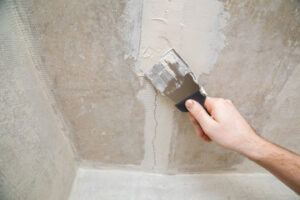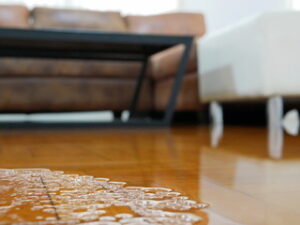Ceiling Repair Perth is a necessary task for maintaining the integrity of a home. It can involve anything from addressing water damage to replacing entire ceilings.

The most common problems homeowners face with their ceilings include cracks, stains, and leaks. These are usually a sign of larger issues that should be addressed immediately.
The shape, length, and location of cracks in a ceiling are important indicators of potential problems. It’s essential to understand the different types of cracks in order to assess whether or not a homeowner needs to call a professional for repairs. It’s also important to understand the difference between structural damage and surface cracking that’s merely cosmetic.
Cracks in ceilings are usually caused by a variety of issues, including normal settling of a building, botched home improvement projects (especially DIY removal of chimney breasts or load-bearing walls), and differences in the rate of expansion and contraction between adjacent sheets of plasterboard in a building’s structure. Cracks in ceilings may also be due to something dangerously precariously balanced on the floor above, such as a piano or heavy bathtub. Cracks in ceilings can also be the result of water leaks, and water damage to a ceiling is often accompanied by sagging, which can be a serious indication of structural damage.
Hairline cracks that are less than 1/16 inch in width are generally considered to be harmless, and the appearance of such cracks is often a result of paint build-up or plaster shrinkage. They may not necessarily signal a major problem, but the homeowner should monitor these cracks and keep an eye out for their growth.
Long cracks that run in a continuous line across a ceiling are a clear sign of structural damage and should always be investigated by a professional. Similarly, cracked ceilings that are paired with sagging in the walls of the building typically indicate significant issues in the foundations, and such cracking is likely to spread.
Cracks in ceilings can be difficult to repair. This is mainly because the repairs must be performed from below the ceiling, and because the materials used to patch up ceiling cracks are different from those used for walls. However, with some time, patience and a good understanding of the causes of ceiling cracks, savvy homeowners can successfully repair them themselves. Typically, this involves using a putty knife to apply a thin layer of drywall mud into the crack and then carefully smoothing it out, feathering the edges with 220-grit sandpaper, and then priming and painting.
Water Stains
Water stains in your ceiling aren’t just unsightly, but they can also be a telltale sign of a much bigger problem. Left unchecked, the staining will promote mold growth and could ultimately cause the ceiling to collapse. Additionally, water stains in the ceiling can ruin your personal possessions and contaminate the rest of your home’s interior. As a result, water stains in the ceiling are often a clear warning signal that you need to fix problems like roof leaks or plumbing issues hiding behind drywall.
The good news is, if you catch these water stains early, they can be fairly easy to treat. The first step is to identify the source of the water stains and fix it if possible (like a leaky roof or faulty HVAC system). After you’ve fixed the issue, it’s time to clean the stained area and get rid of those pesky water spots.
Start by identifying where the water stain is located on your ceiling and ensuring that there’s no structural damage nearby. Once you’re confident that the area is safe, use a ladder to reach the affected area and mix a solution of bleach and water in a spray bottle. Be sure to wear a mask and gloves when working with bleach and work in a well-ventilated area. Spray the bleach solution over the entire area of your ceiling and allow it to set in for a minute or so. Once the area is dry, apply an oil-based undercoat over the water stain to prevent it from peeking through later. It’s a good idea to choose a paint or primer that’s designed specifically for covering stains so you can achieve better coverage. This product will likely say ‘stain block’ or ’stain sealant’ on the packaging.
When the undercoat is completely dry, you can begin repairing and repainting your ceiling. Choose a color that matches the surrounding areas of your ceiling and be sure to apply multiple coats to ensure that the water stains are fully covered. Finally, consider investing in a dehumidifier to help reduce moisture levels in your home, which can also contribute to condensation and water stains.
Leaks
Water leaks from ceilings can cause serious damage to your home, requiring costly repairs and decreasing property value. These leaks typically indicate either a problem with your plumbing or your roof, but they can also reveal signs of underlying issues like mold and mildew. Identifying the source of the leak and tracking it to its origin are critical first steps in making a successful repair.
The most obvious sign of a ceiling leak is water dripping from the surface. This should prompt you to take immediate action before the situation worsens. Water-damaged ceilings are a major turnoff for potential buyers, so they can lower your home’s value. In addition, the dripping water creates an ideal environment for mold and mildew growth, which can be harmful to your health and the integrity of the structure.
Locate the Leak
When water accumulates on the ceiling, it forms a pool that can easily weigh down the ceiling and cause a collapse in severe cases. Use a bucket or similar container to catch the water and prevent further damage. Look for damp areas around light fixtures, vents, and other fixed items on the ceiling. Then, try to follow the water’s path upward. Remember, however, that the source of the leak may not be directly above the wet area, as water tends to travel along pipes and other structures on the ceiling.
If you’re unable to locate the source of the leak, use a moisture detector to track moisture levels in the ceiling. The higher the moisture level, the more likely it is that you have a ceiling leak. You can also place a piece of paper over pipes and other fixtures on the ceiling to absorb moisture and help you find the source.
Once you’ve traced the leak to its origin, it’s important to remove any affected materials and dry the area. This process can be lengthy, but it’s crucial for preventing future problems and ensuring the success of your repair. If the damaged materials are drywall, you should remove it carefully to ensure that you don’t damage the underlying structure. You can speed up the drying process by using fans, dehumidifiers, and other appliances.
Poor Installation
Your ceiling is a critical part of your home that often gets overlooked until something goes wrong. Whether it’s water damage, sagging, or cracks, these issues need to be addressed by professional repair services to ensure the safety and structural integrity of your home.
While some minor damage to a ceiling may be repaired with ease, larger issues will require more time and labor. A contractor will need to assess the damage and find out what caused it before determining how best to fix it. Larger leaks, for example, may require removing and replacing sections of the ceiling to address the source of the problem. Water damage repair can also include mold remediation, which adds to the overall cost.
Depending on the type and severity of the damage, a ceiling repair project can take between 1 to 4 hours to complete. This timeframe is affected by the size of the damaged area, if it needs to be retextured, and what kind of texture is used (popcorn, stucco, etc.). Repainting the entire ceiling or just the patched area will also increase the total repair cost.
Structural problems are more difficult to diagnose and fix than cosmetic issues, but they should be fixed immediately to prevent further damage or safety hazards in your home. Common structural problems include sagging ceilings, broken or loose joists, or rotting rafters. Having a professional inspect these issues is essential to ensure the safety of your family.
The cost of ceiling repair varies greatly depending on the scope of the project and where you live. Typically, labor costs are higher in metropolitan areas because of increased demand. In addition, local materials and living costs impact the cost of repairing your home.
If you are seeing signs of ceiling damage in your home, don’t hesitate to call a professional. Even small cracks or a simple repair job can turn into a major project if left unattended, and it’s always better to be proactive about repairs to keep your home safe and in top condition.


